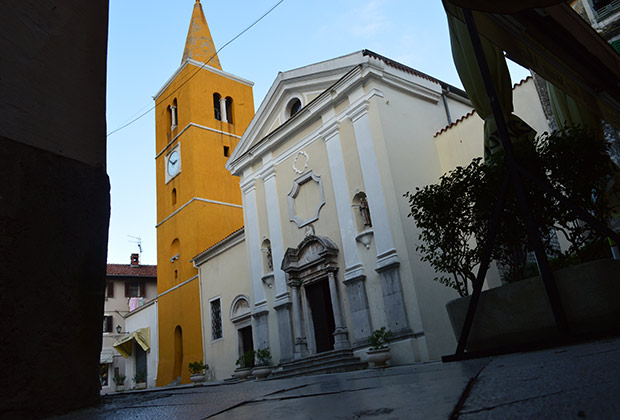
St. George’s Parish Church
The parish church of St. George the Martyr was first mentioned on 9 May 1410, in the will of Lovran's parish priest Raden. The oldest section, the Romanesque base of the square sanctuary, was made between the 12th and 13th centuries. In the 14th and 15th centuries, the Gothic period, the sanctuary was covered with a mesh roof and painted with frescoes.
Most of the frescos were painted by masters from the workshop of Vincent of Kastav. Among the more important pictures are scenes of the Crucifixion on the north wall and scenes depicting the torture of St. George on the lower part of the east wall. On the frescoes there are preserved many graffiti which bear witness to the tradition of Glagolitic script in Lovran. In the Baroque period the church was fortified with supporting arches, which can be seen on the southern side, and with the consequent building of the northern chapels, the church and the belfry were unified. It is thought that, at that time, on the site of today's side chapels of the parish church, there probably stood two separate small churches, the Church of St. Mary and the Church of St. Mathew the Apostle. In around 1700, space for an organ and church choir was put in place. Recent art history has determined the style of the belfry to be Renaissance and dates its creation to the 16th century, or the beginning of the 17th century. In front of the initial facade of the church, which in the Baroque period adopted the appearance it has today, there was a porch. In addition to the frescoes, the interior of the church includes the St. George altar (18th century) and the baptistery (17th century); and in the side chapels there are wooden carved altars: the altar of Anthony of Padua (16th century), the altar of Carmel of the Mother of God (17th century), and the altar of St. Cross (18th century).
Trivia
Stop for a moment and think about the Glagolitic graffiti on the preserved fresco: "It is said by the dead to the living: Why are you looking at me, and why do you wonder, as if you don’t know that I was before as you are today, and you will be tomorrow as I am today? 1549. That was written by deacon Marko“



